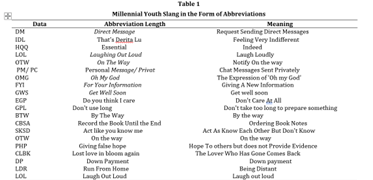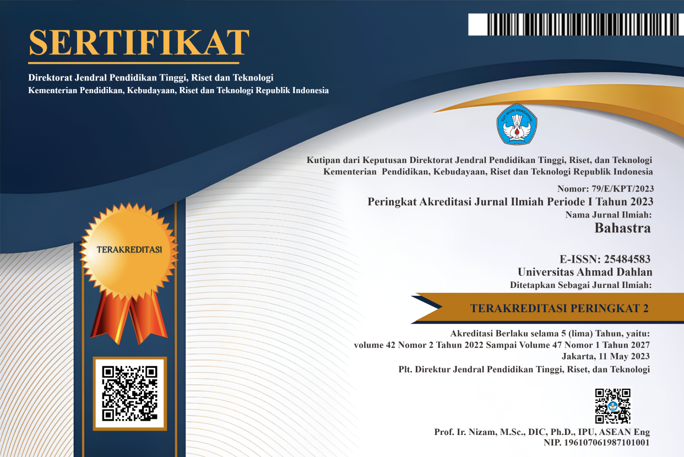Expressions of the use of slang among millennial youth on social media and its impact of the extension of Indonesia in society
DOI:
https://doi.org/10.26555/bs.v43i1.325Keywords:
Slang, Expressions of Milenial Youth, Social Media, IndonesianAbstract
The research was conducted because of the widespread use of slang among the Indonesian population, especially millennial youth. This study also aims to examine millennial youth slang based on its form, source and pattern of formation, purpose and context of use. The research approach used is descriptive qualitative, namely examining language data in the form of the use of slang by millennial youth and interpreting it. Sources of research data are interview results and social media, namely Facebook, Twitter and Instagram, which contain teenage slang. Data collection techniques were documented, observed and recorded, as well as interviews with fifteen young people who used slang in communicating. The data analysis technique in this study is content analysis. The results of the study show that the use of slang by millennial youth originates from regional languages, Indonesian, foreign languages, as well as a combination of Indonesian and foreign languages. The pattern of forming slang from abbreviations, shortening of words, acronyms, reversal of words, spoofed words and shifts in meaning. The expression of the use of slang among millennial youth on social media and its impact on the extension of Indonesian in society makes a big change in the world of language, this is because teenagers are contaminated by foreign languages so this has an impact on the extension of society. Regarding this problem so that ordinary people feel accustomed to and contaminated with the slang that is widely used by millennial youth at this time, this will affect the resilience of the Indonesian national language which is the identity of the country, so that the impact begins to fade the use of good Indonesian and true because it has been contaminated with the influence of foreign languages.
References
Albelbisi, N. A., Al-Adwan, A. S., & Habibi, A. (2023). A qualitative analysis of the factors influencing the adoption of mooc in higher education. TODJE, 24(2), 2-13. https://doi.org/10.17718/tojde.973956
Afria, R., & Wahyudi, G.T. (2020). Analysis of word short forms in the DoTA game. Bastrindo, 1(2), 173-186. https://doi.org/10.29303/jb.v1i2.52
Akyuwen, I., Sasabone, C., & Tabelessy, N. (2020). Variety of slang in the facebook social media of passo youth in Ambon City. Mirlam: Journal of Indonesian Language and Literature Education, 1(1), 93– 102. https://doi.org/10.30598/mirlamvol1no1hlm93-102
Aninsya, W. D., & Rondang, V. N. (2021). Forms of slang words among Instagram social media users. Inscriptions: Journal of Linguistics, 6(1), 120–135. https://doi.org/10.20961/prasasti.v6i1.43270
Ariyanti, N. M. D., Suardhana, I. W., & Mulyawan, I. W. (2018). Slang words used by the characters in neighbors 2: Sorority rising. Humanist Journal, 22(4), 852-859. https://doi.org/10.24843/JH.2018.v22.i04.p03
Ardila, R. R., Ansellyta, A., & Rosi, R. (2018). Analysis of Indonesian Language interference levels in 12-year-old children based on differences in parents language background. Parole: Journal of Indonesian Language and Literature Education, 1(4), 651-658. http://dx.doi.org/10.22460/p.v1i4p651-658.1079
Azizah, A. R. (2019). Use of Indonesian and slang among adolescents. Skripta Journal: Journal of Indonesian Language and Literature Learning, 5(2), 33–39. https://journal.upy.ac.id/index.php/skripta/article/view/424/426
Berliana, A. D., & Anjarningsih, H. Y.. (2022). “Such a Good Night” Analyses of Korean-English code-switching and music video comments of ASTRO’s songs. Indonesian Journal of Applied Linguistics, 12(1), 293-307. https://doi.org/10.17509/ijal.v12i2.32911
Boylu, E., & Kardaş, D. (2020). The views of teachers and students on slang in teaching Turkish as a foreign language. Journal of Language and Linguistic Studies, 16(1), 73–88. https://doi.org/10.17263/jlls.712655
Cho, Y. Z., & Taha, H. (2023). Embracing gen-z learning style with a mobile enthalpy game application (mega) for thermochenical equation. Cakrawala Pendidikan Journal, 42(1) 64-76. https://doi.org/10.21831/cp.v42i1.35394
Daar, G. F., Beratha, N. L. S., Suastra, I. M., & Sukarini, N. W. (2023). The off-record politness strategy and cultural values of the belss negotiation speech event: A sociopragmatic study. Indonesia Journal of Applied Linguistics, 12(3), 612-622. https://doi.org/10.17509/ijal.v12i3.48746
Ertika, R., Chandra W. D. E., & Diani, I. (2019). Variety of slang among teenagers in the city of Bengkulu. Korpus Scientific Journal, 3(1), 84–91. https://doi.org/10.33369/jik.v3i1.7349
Fareed, M. M., & Adisaputera, A. (2020). Linguistics characteristics of social network. Budapest International Research and Critics in Linguistics and Education (BirLE) Journal, 3(4), 2274–2281. https://doi.org/10.33258/birle.v3i4.1510
Fiaji, N.N. (2021). The existence of the walikan language as a symbol of communication in the "gen z" in Malang City. PENSA: Journal of Education and Social Sciences, 3(3), 378–385. https://doi.org/10.36088/pensa.v3i3.1232
Fitriah, L., Indah, A. P., Karimah, K., & Iswatiningsih, D. (2021). Ethnolinguistic study of millennial youth language lexicon on social media. Basastra: Journal of Language and Literature Studies, 10(1), 1– 20. https://doi.org/10.24114/bss.v10i1.23060
Firmansyah, D. (2018). Analysis of language skills in primary school children (study development of child psychology of language). PrimaryEdu: Journal of Primary Education, 2(1), 35-40. https://doi.org/10.22460/pej.v1i1.668
Goziyah, & Yusuf, M. (2019). Slang (prokem) millennial generation in social media (Noermanzah, Gumono, Syafryadin, I. Maisarah, & Sufiyandi (Eds.), 120–125). Publishing and Publication Unit of the University of Bengkulu FKIP.
Hilaliyah, H., Hapsari, S. N., & Jubei, S. (2016). Acquisition of mother tongue at Posyandu Melati III Pejaten Barat. National Seminar Proceeding. https://journal.lppmunindra.ac.id/index.php/repository/article/view/1080/1011
Hudaa, S., & Bahtiar, A. (2020). Millennial language variations: forms of acronyms and palindromes in social media. ESTETIK : Indonesian Journal, 3(1), 41-54. https://doi.org/10.29240/estetik.v3i1.1470
Istiqomah, D. S., Istiqomah, D. S, & Nugraha, F. (2018). Analysis of the use of prokem in social media. Parole: Journal of Indonesian Language and Literature Education, 1(5), 665-674. https://journal.ikipsiliwangi.ac.id/index.php/parole/article
Kuraedah, S., & Mar, N. A. (2016). The impact of slang in the use of Indonesian language for young generations. LANGKAWI, 2(2), 219–232. http://dx.doi.org/10.31332/lkw.v2i2.464
Mashaqba, B., Huneety, A., Guba, A. M., & Al-Duneibat, B. (2022). Production of gutturals by non-native speakers of Arabic. Indonesian Journal of Applied Linguistics, 12(2), 334-347. https://doi.org/10.17509/ijal.v12i2.26143
Mastuti, I. (2008). Standard language vs slang. Hi-Fest Publishing.
Meilani, M. (2014). Culture through digital media. Humanities, 5(2), 1009–1014. https://doi.org/10.21512/humaniora.v5i2.3210
Miles, M. B., & Huberman, A. M. (2009). Qualitative data analysis. UI-Press.
Mujianto, G. (2015). The teacher's speech acts in learning to write with a directed composition based on the level of students' cognition. KEMBARA: Scientific Journal of Language, Literature, and Teaching, 1(2), 173–197. https://doi.org/10.22219/kembara.v1i2.2614
Muklis, Y. M., Subanti, S., & Sujadi, I. (2018). Development of mathematical skill assessment instruments in secondary school based on Bloom’s taxonomy. In Journal of Physics: Conference Series, 1028(1), 012147. IOP Publishing. https://doi.org/10.1088/1742-6596/1028/1/012147
Muliana, H., & Sumarni, S. (2015). Analysis of the moral value of slang (alay) on youth education on social media. Journal of Confix, 2(1), 69–83. https://doi.org/10.26618/jk.v2i1.407
Mulyana. (2008). Indonesian for college. Adhigama Foundation.
Nisrina, D., Widodo, I. A., Larassari, B., & Rahmaji, F. (2020). The impact of Korean cultural consumerism (KPOP) among students of the Faculty of Social Sciences, State University of Malang. Journal of Humanities Research, 21(1), 78–88. https://doi.org/10.23917/humaniora.v21i1.8085
Norma, N. (2020). The use of slang in oral communication in SMA Negeri 7 Palu. Journal of Language and Literature, 5(4), 70–80. http://jurnal.untad.ac.id/jurnal/index.php/BDS/article/view/12746
Nuraeni, F. W., Pahamzah, J., Sultan, U., & Tirtayasa, A. (2021). An analysis of slang language used in teenager interaction. Litera, 20(1), 313–322. https://doi.org/10.21831/ltr.v20i2.37058
Pratiwi, Y., Andajani, K., Suyitno, I., Ismail, A., & Prastio, B. (2023) Representing and Implementing moral values in foreign students in Indonesia textbooks for learners other than indonesians. International Journal of language Education, 7(1) 58-76. https://doi.org/10.26858/ijole.v1i1.36256
Prihatini, A. (2019). Semantic network of the word association in the field of law. Litera, 18(3), 430- 446. https://doi.org/10.21831/ltr.v18i3.26513
Sari, B. P. (2015). The impact of using slang among teenagers on Indonesian. Unpublished Thesis. Bengkulu, Bengkulu University.
Sarlina, S. (2018). Reasons for using Indonesian puns on facebook social media. Idiomatic, 1(1), 10–16. http://ejournals.umma.ac.id/index.php/idiomatik/article/view/194
Schneider, S., Nebel, S., Pradel, S., & Rey, G. D. (2015). Introducing the familiarity mechanism: A unified explanatory approach for the personalization effect and the examination of youth slang in multimedia learning. Computers in Human Behavior, 43, 129–138. https://doi.org/10.1016/j.chb.2014.10.052
Sibarani, R. (2003). Phenomenon of language play in Indonesian in Indonesian Linguistics. Scientific Journal of the Indonesian Linguistic Society, 4(2), 20-32.
Smith-Hefner, N.J. (2012). Youth language, slang sociability, and the new Indonesian middle class. Journal of Youth Studies, 1(1), 61–82. https://doi.org/10.22146/studipemudaugm.32076
Susanti, E. (2016). Glossary of Indonesian vocabulary in a variety of social media. DIALEKTIKA: Journal of Language, Literature, and Indonesian Language and Literature Education, 3(2). https://doi.org/10.15408/dialektika.v3i2.5188
Ulfah, L. N. (2021). The use of millennial youth languages in Malang City. Journal of Research, Education, and Learning, 16(24), 2–9.
Widawati, R. R. (2018, November). The influence of social media on language habits. In National Seminar SAGA# 3 (Literature, Pedagogy, and Language), 1(1), 405-414.
Wijana, I. D. P. (2012). The use of English in Indonesian adolescent's slang. Humanities, 24(3), 315–323.
Zein, D., & Wagiati, W. (2018). Youth slang as the linguistic creativity of its speakers on social media in the era of information and communication technology. Journal of Sociotechnology, 17(2), 236–245. https://doi.org/10.5614/sostek.itbj.2018.17.2.6

Downloads
Published
Issue
Section
License
Copyright (c) 2023 Dedi Saputra, Vismaia S Damayanti , Yeti Mulyati, Wahyudi Rahmat

This work is licensed under a Creative Commons Attribution-ShareAlike 4.0 International License.

1.jpg)






